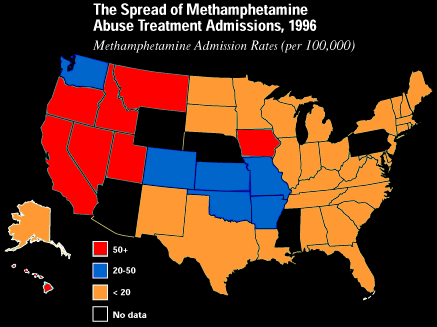
First synthesized in 1887 in Germany, amphetamine was for a long time, a
drug in search of a disease. Nothing was done with the drug, from its
discovery (synthesis) until the late 1920's, when it was seriously
investigated as a cure or treatment against nearly everything from
depression to decongestion.
In the 1930's, amphetamine was marketed as Benzedrine in an
over-the-counter inhaler to treat nasal congestion (for asthmatics, hay
fever sufferers, and people with colds). A probable direct reaction to
the Depression and Prohibition, the drug was used and abused by
non-asthmatics looking for a buzz. By 1937 amphetamine was available by
prescription
in tablet form.
Methamphetamine, more potent and easy to make, was discovered in Japan
in 1919. The crystalline powder was soluble in water, making it a
perfect candidate for injection. It is still legally produced in the
U.S., sold under the trade name Desoxyn.
During World War II, amphetamines were widely used to keep the
fighting men going (during the Vietnam War, American soldiers used more
amphetamines than the rest of the world
did during WWII). In Japan, intravenous methamphetamine abuse reached
epidemic proportions immediately after World War II, when supplies
stored for military use became available
to the public.
In the United States in the 1950s, legally manufactured tablets of
both dextroamphetamine (Dexedrine) and methamphetamine (Methedrine)
became readily available and were used non medically by college
students, truck drivers, and athletes. As use of amphetamines spread, so
did their abuse. Amphetamines became a cure-all for such things as
weight control to treating mild depression.
This pattern changed drastically in the 1960s with the increased
availability of injectable methamphetamine. The 1970 Controlled
Substances Act severely restricted the legal production of injectable
methamphetamine, causing its use to decrease greatly.
Methamphetamine trafficking and abuse in the United States have been
on the rise over the past few years, as indicated by investigative,
seizure, price, purity, and abuse data (see "trends" below). As a
result, this drug is having a devastating impact in many communities
across the nation. Although more common in western areas of the country,
this impact increasingly is being felt in areas not previously familiar
with the harmful effects of this powerful stimulant.
Clandestine production accounts for almost all of the methamphetamine
trafficked and abused in the United States. The illicit manufacture of
methamphetamine can be accomplished in a variety of ways, but is
produced most commonly using the ephedrine/pseudoephedrine reduction
method. Large-scale production of methamphetamine using this method is
dependent on ready access to bulk quantities of ephedrine and
pseudoephedrine. During the past two years, several bulk ephedrine
seizures destined for Mexico focused
attention on the magnitude of ephedrine acquisition by organized crime
drug groups operating from Mexico and in the United States, and set in
motion an effort to focus
international attention on the ephedrine diversion problem and to take
action to prevent such diversion.
Drug law enforcement efforts against clandestine methamphetamine
producers constitute a "cat and mouse" game between efforts to cut off
chemical supplies and efforts to obtain
them from non-regulated sources. Past experience has demonstrated that
methamphetamine traffickers are relentless, flexible, and creative in
finding new ways to obtain
chemicals by evading the network of international controls that has been
established. The Federal Government currently is preparing regulations
to further reduce the diversion of pharmaceutical products containing
chemicals, such as ephedrine and pseudoephedrine, that can be used to
produce illegal drugs. It has consulted with corporations within the
pharmaceutical industry to develop a solution to the diversion problem
that does not unduly restrict the availability of these chemicals for
legitimate use.
Domestically, large-scale production of methamphetamine is centered
in California. In addition, methamphetamine increasingly is produced in
Mexico and smuggled into the United
States. Methamphetamine laboratory operators often are well-armed, and
their laboratories occasionally are booby-trapped and equipped with
scanning devices employed as security
precautions. Weaponry, ranging from single firearms to arsenals of
high-powered weapons and explosives, are commonly found at laboratory
sites. Not only are methamphetamine
laboratories used to manufacture illegal, often deadly drugs, but the
clandestine nature of the manufacturing process and the presence of
ignitable, corrosive, reactive, and toxic chemicals at the sites have
resulted in explosions, fires, toxic fumes, and irreparable damage to
human health and to the environment.
Traditionally, the suppliers of methamphetamine throughout the United
States have been outlaw motorcycle gangs and numerous other independent
trafficking groups. Although these groups continue to produce and
distribute methamphetamine, organized crime drug groups operating from
Mexico currently dominate wholesale methamphetamine trafficking in the
United States for several reasons: these organizations established
access to wholesale ephedrine sources of supply on the international
market; these organizations are producing unprecedented quantities of
high-purity methamphetamine on a regular basis; and, they already
control well-established cocaine, heroin, and marijuana distribution
networks throughout the western United States, enabling them to supply
methamphetamine to a large retail level market. Their expansion into the
methamphetamine trade has added a new dimension to their role in the
U.S. drug market and has redefined the methamphetamine problem in the
United States. Presently, these organizations are poised to supply
methamphetamine to the rest of the country in response to any increases
in demand.